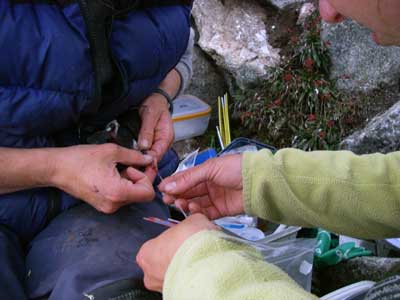Jerome Fort is a PhD student at the DEPE (Département d’Ecologie, Physiologie et Ethologie) lab and is funded by the University of Strasbourg located in Strasbourg, France. He is conducting some of his field research here, along with participating as a field assistant to Ann’s Little Auk research.
 Jerome with the auks
Jerome with the auks
Jerome with the auks.
Supervised by David Gremillet, Jerome‘s PhD focuses on Little auk wintering ecology with the long term objective to have a better understanding of the adaptations of this species to the variations in environment conditions as the climate changes. Using a model developed by Warren Porter, one part of this research will allow for the estimation of energy expenditure of Little Auks during both the breeding and winter season. This summer, Jerome is looking at nest parameters themselves, necessary to estimate the energy expenditure during the breeding season and to compare it with the winter season.
When a Little auk is in the nest, its’ energy expenditure may be relative to the depth of the nest, the nest insulation, and the reflectivity of the rock, all of which affect nest temperature. Near the end of this field season, TDR’s (temperature/Depth Recorders) will be placed in several nests at this colony, deep and shallow, to record temperature data. The model will use a variety of measurements including behavioral activity, temperature in the nest, and winter solar radiation at sea to estimate the Little Auks’ energy expenditure during the summer and winter periods.
The question to be answered is; what is the energy expenditure of these birds in winter? Is it different than the breeding season energy expenditure? This winter, TDR’s in Spitsbergen will record winter diving behavior, to provide some of the wintering behavioral data. When all this data is compiled a more accurate model of overall energy expenditure may be available. Then a calculation, using an annual time budget, can be made of the energy needs of the species at each portion of its annual cycle. Predictions can then be made about how the Little Auk will respond to changes in food (or energy) availability associated with climate change.
In collaboration with Yves Cherel, another portion of Jerome’s doctoral research is to determine what the adults themselves consume. Although Little Auk chick diet is easy to quantify because parents bring whole zooplankton back to the colony, relatively little is known about adult diet. Based on stable isotope analysis and on the idea that "we are what we eat”, an analysis of body tissue can discover what food has been consumed.
This concept applies to most animals which have been studied. The protein consumed in any diet goes into the body tissue, with an eventual turnover. Blood turnover (when a portion of blood is completely replaced by new blood) occurs every few weeks. At any time, a blood analysis will indicate what was eaten a few weeks before. The plasma in blood turns over in two or three days. But, feathers are ‘dead’ tissue, much like hair. Feathers will reflect the diet consumed during the feathers growth. And since it is dead tissue, there is no turnover. If winter feathers can be collected, winter diet can be obtained. If the carbon and nitrogen in the feathers is analyzed, it can be found what trophic level of organisms the food was obtained from and where (inshore or offshore). Based on the nitrogen analyzed it can found if the diet is zooplankton, fish larvae or possibly fish, since each has a different protein ‘signature’.
Jerome has been collecting head and body feathers and blood samples. When the birds arrived at the colony in June he took head and body feathers. Because Little Auks have a complete molt in September after the breeding season, the stable isotope analysis on them will give the late summer/fall diet and trophic level. But Little Auks also have a second partial molt during the Spring when head feathers are replaced. Consequently, the stable isotope analysis of these head feathers will give spring diet and trophic level. In the same way, blood taken from winter Little Auks killed by hunters next to the South West Greenland coasts, saved and frozen for Jerome, will give winter diet and trophic level. Finally, blood taken this summer will give this summer’s diet and trophic level.
 A vein is pricked and a capillary tube is filled and transfferred to a microcentrifuge tube.
A vein is pricked and a capillary tube is filled and transfferred to a microcentrifuge tube.
 A larger amount of blood is collected from the recaptured doublely-labeled water birds.
A larger amount of blood is collected from the recaptured doublely-labeled water birds.
Jerome will compile and examine the data to investigate Little Auk diet throughout the entire annual cycle and determine if there is a shift in trophic level foraging between seasons. He will also try to find out whether adults feed on different prey than the chicks, if there is more offshore or inshore consumption, and if there are seasonal and sex differences. With a total of four colonies collecting feather and blood samples for Jerome’s study (1 in Greenland and 3 in Spitsbergen), he anticipates being able to compare the winter feeding between the four colonies and also differences at a smaller scale between the three colonies at Spitsbergen. An added benefit to this relatively new technique is that it is non invasive for the birds, since they are only minimally disturbed and then, only temporarily.
Jerome has had an interest in working with animals since he was a child. His original goal was to become an ornithologist. With a Bachelors degree in Biology and Zoology and a Master’s degree in Ethology and Ecology, Jerome’s focus now is to continue to research marine birds. Once his doctorate is obtained Jerome will work towards a position with the National Center of Scientific research in France.
**Vocabulary: **
Trophic level
Reflectivity
Protein signature
Carbon
Nitrogen
Stable isotope
Molt

